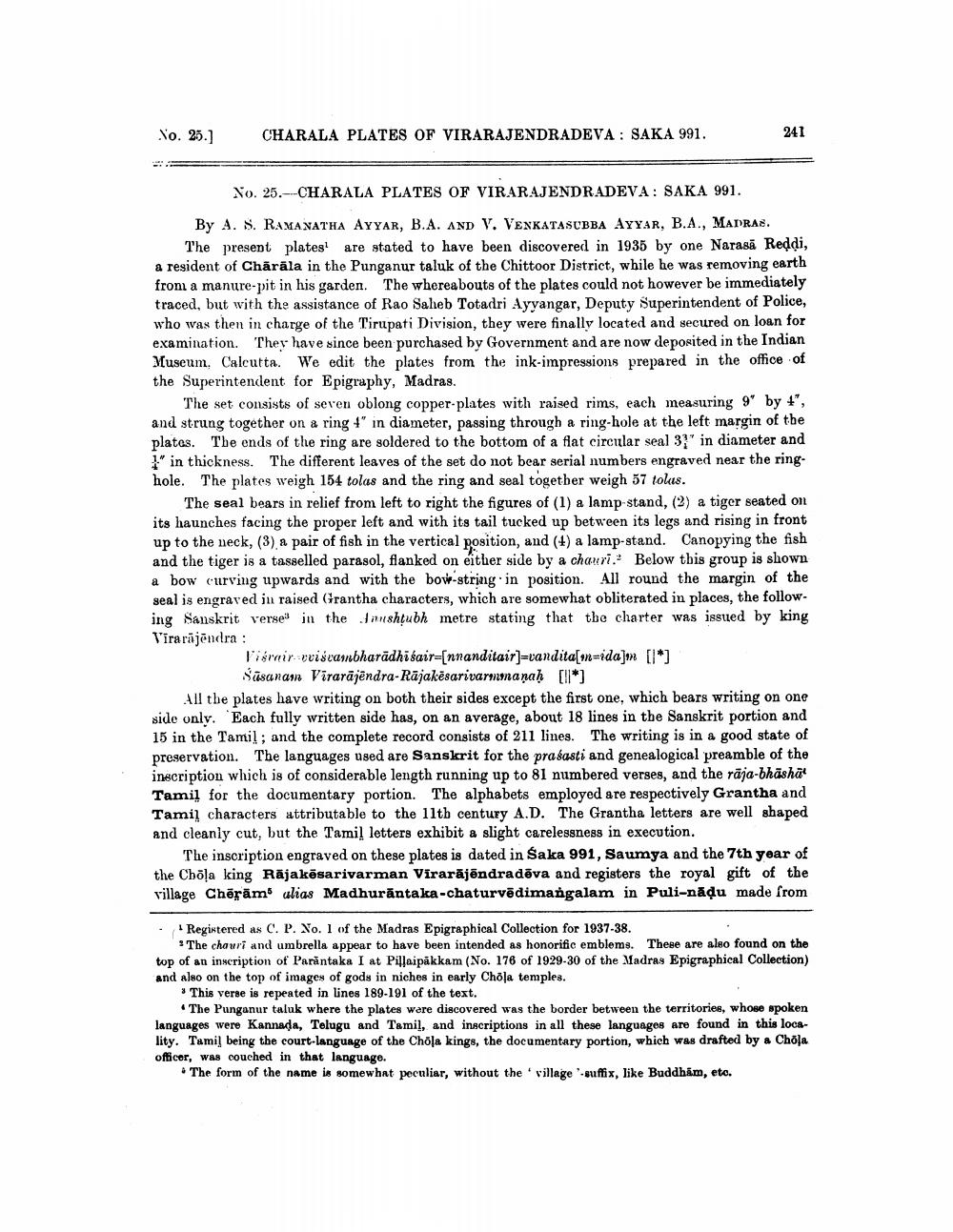________________
No. 25.]
CHARALA PLATES OF VIRARAJENDRADEVA: SAKA 991.
241
Xo. 25.-CHARALA PLATES OF VIRARAJENDRADEVA: SAKA 991. By A. S. RAMANATHA AYYAR, B.A. AND V. VENKATASUBBA AYYAR, B.A., MADRAS.
The present plates! are stated to have been discovered in 1935 by one Narasā Reddi, a resident of Chārāla in the Punganur taluk of the Chittoor District, while he was removing earth from a manure-pit in his garden. The whereabouts of the plates could not however be immediately traced, but with the assistance of Rao Saheb Totadri Ayvangar, Deputy Superintendent of Police, who was then in charge of the Tirupati Division, they were finally located and secured on loan for examination. They have since been purchased by Government and are now deposited in the Indian Museum. Calcutta. We odit the plates from the ink-impressions prepared in the office of the Superintendent for Epigraphy, Madras.
The set consists of seven oblong copper-plates with raised rims, each measuring 9 by , and strung together on a ring 4" in diameter, passing through a ring-hole at the left margin of the plates. The ends of the ring are soldered to the bottom of a flat circular seal 31' in diameter and 1' in thickness. The different leaves of the set do not bear serial numbers engraved near the ring. hole. The plates weigh 154 tolas and the ring and seal together weigh 57 tolus.
The seal bears in relief from left to right the figures of (1) a lamp-stand, (2) a tiger seated on its haunches facing the proper left and with its tail tucked up between its legs and rising in front up to the neck, (3) a pair of fish in the vertical position, and (+) a lamp-stand. Canopying the fish and the tiger is a tasselled parasol, flanked on either side by a chauri. Below this group is shown a bow curving upwards and with the bove-string in position. All round the margin of the seal is engraved in raised Grantha characters, which are somewhat obliterated in places, the following Sanskrit verse in the mushtubh metre stating that the charter was issued by king Virarājēndra:
Pirnir visvannbharadhiếair=[nnanditair)-vandita[m-ida] [1*]
Sūsanan Virarājandra-Rājakësarivarmmanah [*] All the plates have writing on both their sides except the first one, which bears writing on one side only. Each fully written side has, on an average, about 18 lines in the Sanskrit portion and 15 in the Tamil; and the complete record consists of 211 lines. The writing is in a good state of preservation. The languages used are Sanskrit for the prasasti and genealogical preamble of the inscription which is of considerable length running up to 81 numbered verses, and the raja-bhāshā. Tamil for the documentary portion. The alphabets employed are respectively Grantha and Tamil characters attributable to the 11th century A.D. The Grantha letters are well shaped and cleanly cut, but the Tamil letters exhibit a slight carelessness in execution.
The inscription engraved on these plates is dated in Saka 991, Saumya and the 7th year of the Chola king Rājakēsarivarman Virarājēndradēva and registers the royal gift of the village Chērāms alias Madhurāntaka-chaturvēdimangalam in Puli-nāļu made from
• Registered as C. P. No. 1 of the Madras Epigraphical Collection for 1937-38.
The chouri and umbrella appear to have been intended as honorific emblems. These are also found on the top of an inscription of Parantaka I at Piljaipakkam (No. 176 of 1929-30 of the Madras Epigraphical Collection) and also on the top of images of gods in niches in early Chola temples.
. This verse is repeated in lines 189-191 of the text.
• The Punganur taluk where the plates were discovered was the border between the territories, whose spoken languages were Kannada, Telugu and Tamil, and inscriptions in all these languages are found in this locality. Tamil being the court-language of the Chola kings, the documentary portion, which was drafted by a Chola officer, was couched in that language.
The form of the name is somewhat peculiar, without the village suffix, like Buddham, eto.




